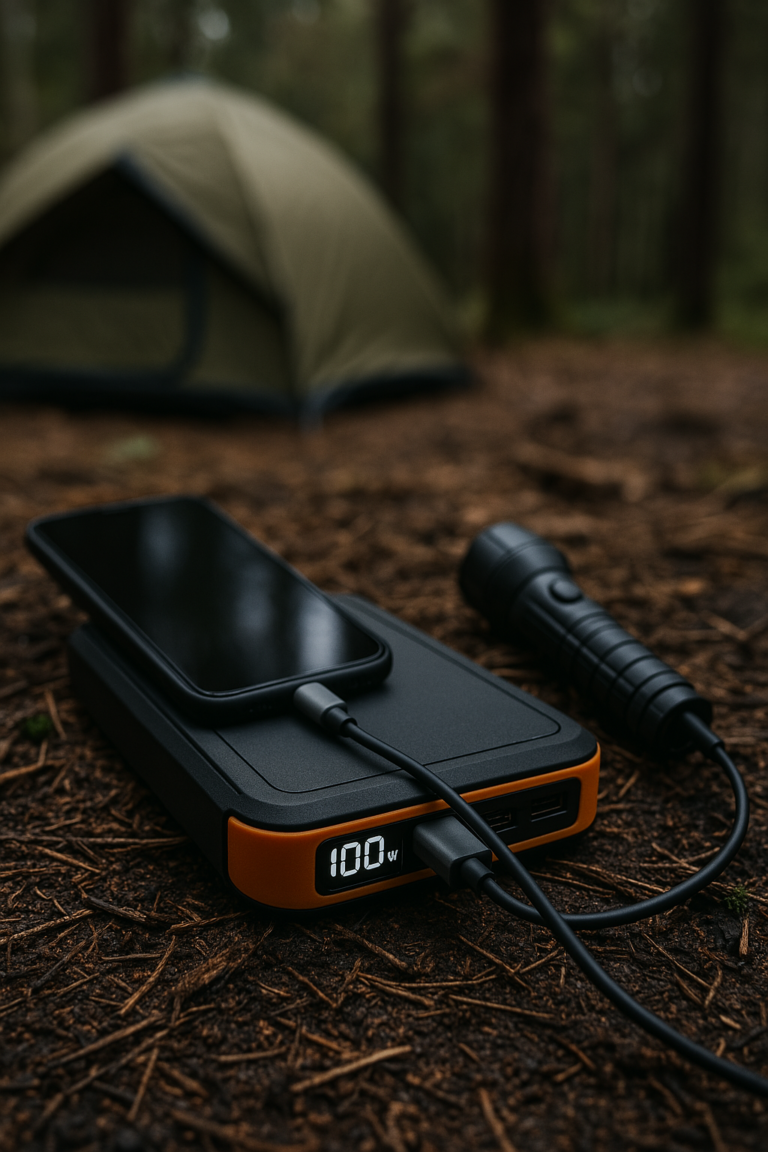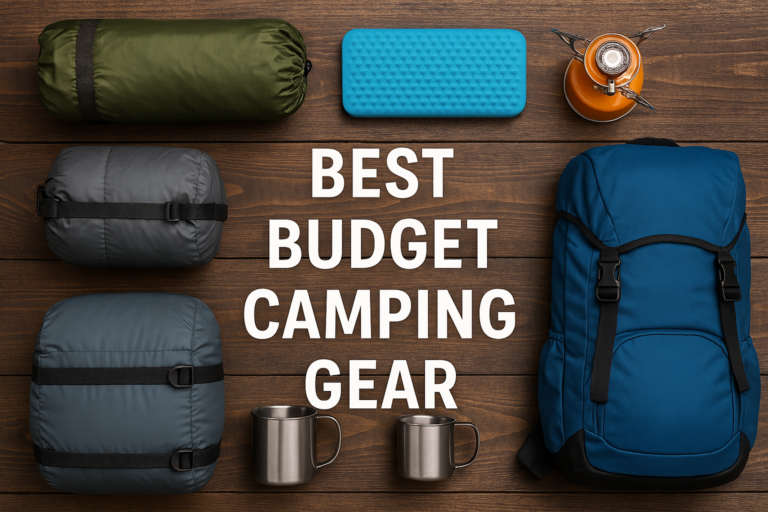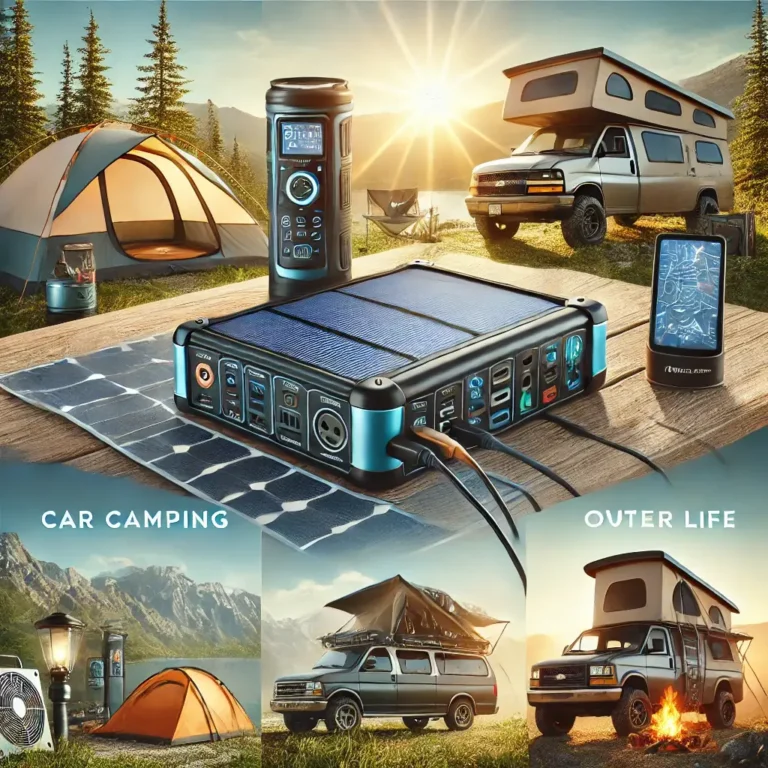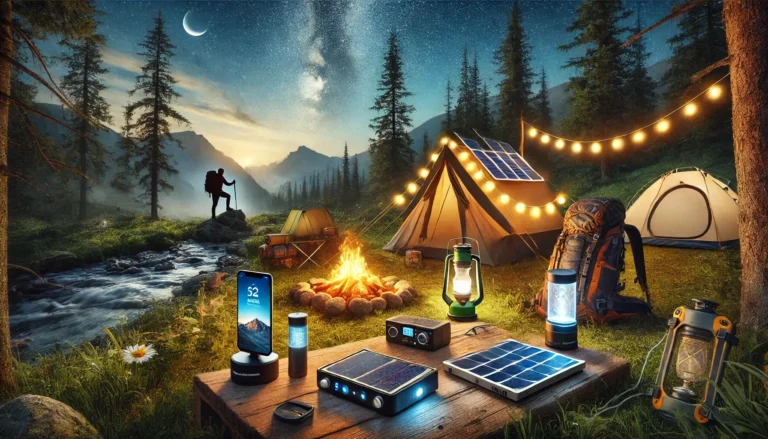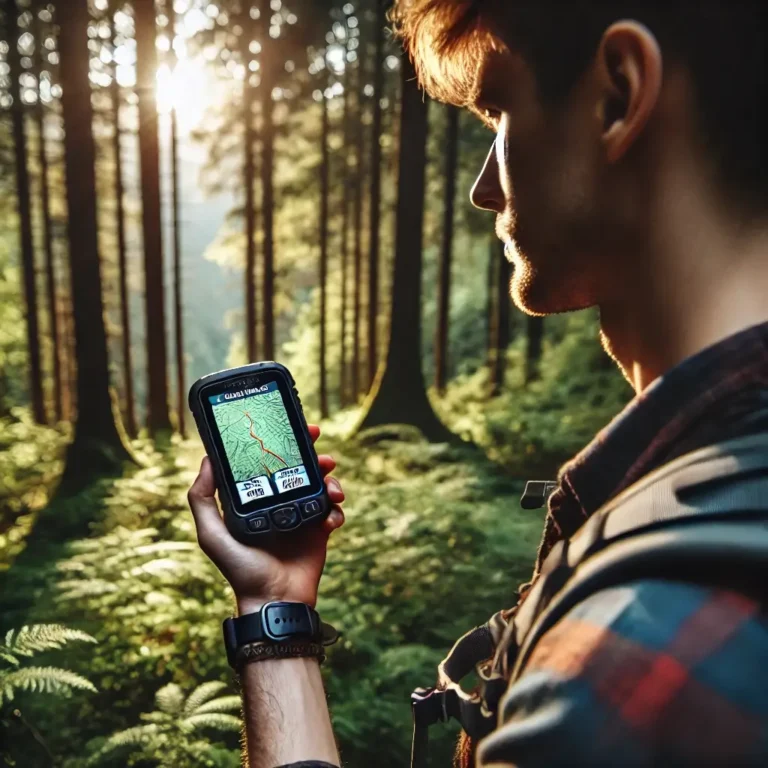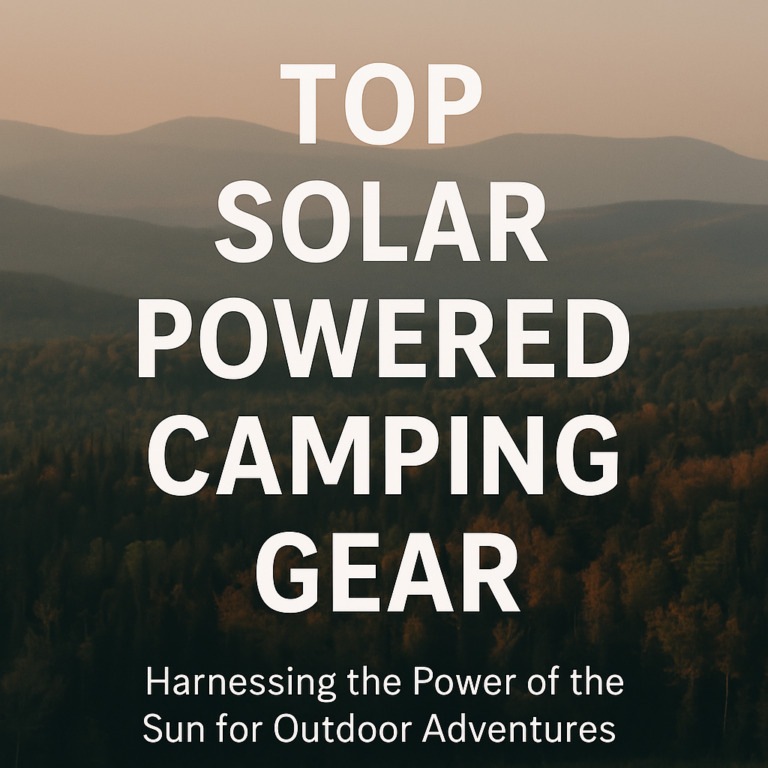Cold Weather Camping Technology: The Ultimate Guide
Introduction
There’s something magical about camping in the winter. Think of clean snow, quiet nights, and clear star-filled skies that summer campers miss. But winter camping has big challenges. Winter camping has grown by 34% since 2020. Yet almost half of first-time winter campers don’t come back because they got too cold! Today’s cold weather camping technology doesn’t just make winter trips possible – it makes them fun.
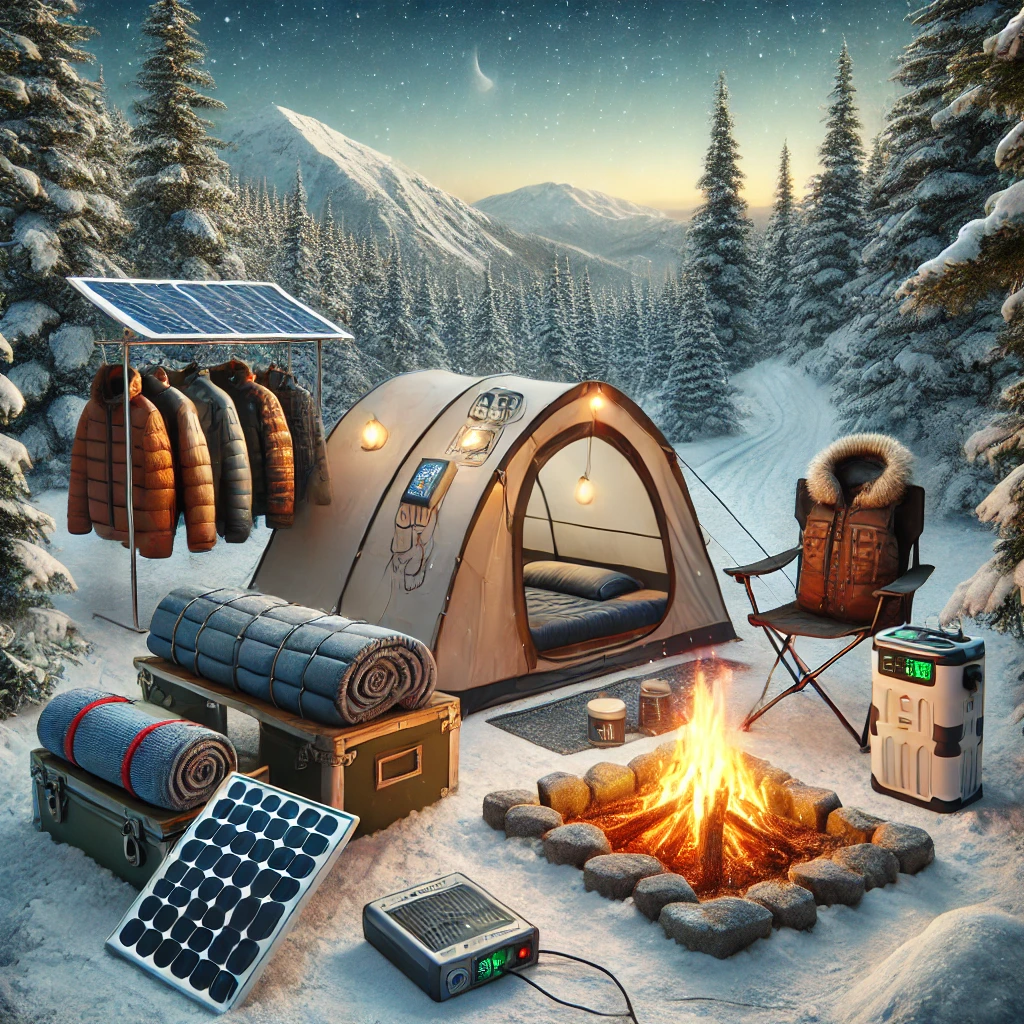
Essential Cold Weather Camping Technology for Staying Warm
My first winter camping trip taught me a hard lesson. I went to the Rockies with the wrong gear. It was 15 below zero that night! I shivered all night in my thin tent. I didn’t sleep at all. That awful night changed how I camp in cold weather.
Cold weather camping technology has improved a lot in recent years. Modern materials and smart designs help keep body heat better. Battery-heated clothing has made staying warm easier than ever. Winter camping technology now includes special gear for each part of your body.
Heated Clothing: A Game Changer
Heated clothes are amazing for winter camping. Today’s camping gadgets go far beyond basic gear. They keep you warm even when it’s below zero, and they’re light too.
Remember to keep spare batteries in your sleeping bag at night so they stay charged!
Battery-heated clothing for camping has changed winter outdoor trips. These clothes offer different heat settings so you can adjust warmth as needed. The heating parts target your chest and back to work better.
Some advanced models include heated collars and pockets. Cold-resistant power banks can make these heating systems last longer, letting you stay out even in very cold weather.
Winter-Specific Tents
Winter tents matter more than you might think. They have less mesh and more solid walls to keep heat in. They sit lower to the ground to block wind and they also have a special front area that stops cold air while letting the tent breathe.
Smart tents for cold weather are very different from summer models. They have stronger poles designed to handle heavy snow and high winds. The best four-season tent technology includes strong anchor points for stability in storms.
Look for models with front storage areas big enough to keep snow-covered gear without bringing moisture into your sleeping area. Some advanced cold weather camping technology includes small air vents that reduce moisture buildup without letting too much heat escape.
Insulation From Below
Your sleeping pad is super important. When you lie on your sleeping bag, it gets flat and can’t keep you warm from below. You need a pad with a high R-value for winter. R-value tells you how well it blocks cold. Get one with at least R-5 for winter.
Insulation technology has made huge advances in sleeping pads. The latest extreme weather sleeping bags use advanced materials that stay puffy even when damp. Some new cold weather camping technology combines foam layers with air chambers to be both comfy and warm.
For very cold camping, look for pads with shiny barriers that reflect body heat back up toward you. Always check the temperature rating of your pad and bag together—they work as a team for winter camping.
Winter-Rated Sleeping Bags
Never go cheap on a winter sleeping bag. Many brands stretch the truth about how warm their bags are. Look for bags with EN/ISO ratings. These are tested by independent labs. Always buy a bag rated for colder than you expect.
Cold weather camping technology in sleeping bags often includes draft collars, insulated zipper flaps, and foot-warming pockets. The most effective extreme weather sleeping bags use special cutting so the inner lining is smaller than the outer shell. This prevents flat spots at the seams.
New graphene-enhanced camping gear offers great heat keeping with less weight. Some cold weather camping technology even uses special materials that absorb and release heat to keep you at the right temperature all night.
Cold-Resistant Power Banks
Battery packs have gotten much better. A 20,000 mAh power bank can charge your heated gear and phone multiple times. Look for ones that work in very cold weather and keep them in an insulated pouch.
These camping tech upgrades make a big difference in winter. The latest cold weather camping technology includes special batteries that work in temperatures as low as -40°F. These cold-resistant power banks often have rubber-armored cases and waterproof designs.
Some advanced models include LED screens that show exact battery levels and charging rates. Always look for cold weather power banks that prevent charging when batteries are too cold. This protects both your devices and the power bank itself.
Wool Base Layers
Wool base layers with silver in them work great. The silver stops smells (your tent mates will thank you). The wool keeps you warm and dry. Wool costs more but works better than synthetics for trips longer than a day.
Wearable technology for extreme cold starts with your base layer. Modern merino wool mixes include special fibers that move sweat while keeping heat. The best wool for cold weather camping comes from special sheep raised in mountains. These have naturally curly fibers that create millions of tiny air pockets for keeping you warm.
Silver-added wool uses tiny silver bits attached to the fiber to fight bacteria growth during long trips. Unlike synthetic materials, wool keeps insulating even when wet, making it ideal winter camping gear for changing conditions.
Chemical Hand and Foot Warmers
Old-school hand warmers are still useful as backups. Some brands make warmers for boots that last 8+ hours. They’ve saved my toes many times when batteries died.
These simple but effective items are proven cold weather camping technology. Modern versions use iron powder that reacts with air to make steady heat for up to 10 hours. Look for air-activated warmers made for winter camping gear like gloves, boots, and sleeping bags.
Some advanced versions have sticky backing to stay in place over key areas. For lightweight winter camping gear, look at the new super-thin warmers that weigh less than old types. These reliable survival items for snow camping work without batteries or charging, making them perfect emergency backups.
Power Management Systems for Extended Cold Weather Expeditions
I got really scared on my Alaska trip. My battery pack died on day three. It was 25 below zero! I couldn’t use my GPS, headlamp, or emergency radio. This scared me a lot.
Portable power for cold weather must account for increased usage in cold conditions, as many devices use more power when cold. Long winter trips require careful planning of your electrical needs.
Winter camping power solutions must have backups, with main and spare systems. Every item in your cold weather camping technology power kit should be rated for the lowest temperatures you expect to face.
Cold Weather Battery Basics
Most people don’t know that cold cuts battery life in half. When it’s below freezing, your battery might only last half as long. Also, if you charge cold batteries, you can hurt them for good. Good battery care keeps you safe.
Cold-weather battery life improvement depends on understanding how batteries work. Lithium batteries work better than regular or rechargeable ones in freezing conditions. The portable battery technology for extreme cold often includes special insulating cases.
Some advanced cold weather camping technology batteries have built-in heating parts that turn on automatically when temperatures drop too low. Always warm batteries slowly before charging—quick temperature changes can cause lasting damage. Keep spares for important devices in inner pockets where body heat keeps them at the right temperature.
Solar Panels Work in Winter
Solar panels work well in cold weather. They work better when cold because they send power better. Snow even helps by bouncing more sun onto the panels. But you must keep snow off the panels. Never count on solar panels as your only power. Cloudy days mean less power.
Cold-ready solar panels have changed winter camping power solutions. The latest portable power for cold weather includes folding panels with strong connection points that handle repeated setup in freezing conditions. Some solar chargers for winter camping include built-in power banks that store energy even when your devices aren’t connected.
The best cold weather camping technology in this group includes panels with special parts that optimize output even in partial shade or low light. Look for models with snow-shedding surfaces and waterproof connection boxes designed specifically for winter camping gadgets.
Cold-Rated Power Storage
Pick battery banks made for cold. Look for ones that work down to -4°F or colder. Normal battery banks stop at 32°F. For long trips, get at least 20,000 mAh. This can charge a phone about 5-6 times. New USB-C models charge faster.
Portable power for cold weather has seen big improvements. Today’s cold-resistant power banks often feature multiple output ports with smart charging circuits that deliver the best current to each connected device. Some have built-in temperature sensors and heating systems that keep the battery working right even in freezing conditions.
The best cold weather camping technology in this group includes pass-through charging ability, letting you recharge the bank while it powers your devices. For arctic trip technology needs, look for models with strong cases that can handle accidental drops on frozen ground.
Battery Maintenance in the Field
Keeping batteries warm makes them last longer. Use neoprene cases and wrap them in a sock. Keep all batteries in a small warm pouch near your body during the day. At night, put batteries in your sleeping bag. Your body heat keeps them warm. But don’t put them right on your skin while you sleep.
Cold weather power management requires smart strategies. Special battery pouches with shiny lining help trap heat while blocking moisture. Some winter camping technology essentials include battery cases with passive heating elements that absorb body heat during the day and release it slowly at night.
Advanced cold weather battery life improvement techniques include moisture barriers that prevent damaging condensation when moving between temperature extremes. Always organize batteries by type and charge level to minimize exposure time when swapping them in cold conditions.
Hand-Crank Emergency Options
I always bring a hand-crank charger for backup. These make just enough power for quick calls or checking GPS. Four minutes of cranking gives about two minutes of phone use. Some stoves make power while you cook. They don’t make much power, but can slow-charge while you melt snow or cook food.
These winter camping gadgets are crucial survival technology for snow camping. Modern hand-crank generators work much better than older models, with gear systems that turn your cranking motion into electrical output. Some advanced cold weather camping technology includes combination units that offer hand-crank, solar, and even water-flow charging options.
The best models include built-in flashlights and emergency sirens powered by the same charging system. While these devices make limited power, they can provide critical emergency communication ability when main systems fail in extreme conditions.
Power Conservation Tips
The best plan is to use less power. Turn off things you don’t need. Put phones in airplane mode. Turn off apps running in the background. Lower screen brightness. Turn off alerts. Bring a GPS device instead of using your phone’s GPS. Download maps before you go.
Smart cold weather power management starts with understanding how devices behave in low temperatures. Screens use much more power when cold, so limiting screen time becomes essential for winter camping power solutions. Set up your smartphone winter protection settings to save battery life—turn off automatic updates, location services, and notifications.
For important navigation devices, winter wilderness navigation tools like dedicated GPS units use much less power than smartphone apps. Offline mapping for winter trails should be downloaded and tested before leaving, as data connections drain batteries quickly in cold conditions.
Communication and Safety Technology for Remote Winter Camping
I learned about safety gear the hard way. Five years ago, I got lost in a snowstorm in Montana. My phone had no signal as temperatures dropped to -10°F. Heavy snow covered the trail markers. I couldn’t see more than ten feet ahead. I was alone and scared for six hours until the storm passed and I found my way back to camp.
Survival technology for snow camping must include reliable communication gear. Remote winter locations often lack cell coverage, making special equipment necessary. Cold weather camping technology for emergency communication should work regardless of temperature or weather conditions.
Every winter camping gear list should include multiple ways to call for help if needed. Avalanche safety technology becomes essential in areas with potential snow slides.
Satellite Communicators Save Lives
Cell phones don’t work in most wild places. Satellite devices work almost anywhere with a clear view of the sky. These reliable devices let you text family or rescue teams even when you’re completely off the grid. They also track your location throughout your journey.
Some models let you share your trip route online so people know exactly where to look if you’re late returning. I’ve seen these devices save lives when hikers got injured miles from help.
Satellite communicators for remote camping can truly save your life. These devices connect to satellites that provide coverage almost anywhere on Earth. Advanced models let you send messages, share your location, and get weather forecasts.
Some emergency beacons for winter trips combine satellite messaging with emergency beacon functions. Winter wilderness navigation tools often include satellite communication as a key safety feature. Always test your device before each trip and learn how to use it in emergencies.
Personal Locator Beacons for Emergencies
A PLB (Personal Locator Beacon) is different from satellite messengers. It only does one thing – call for rescue when you’re in serious trouble. But it does this very well. The best thing about PLBs is they need no subscription or monthly fees. You buy it once, register it, and it’s ready when needed.
The battery lasts for years. However, you can only use it for genuine life-threatening emergencies. PLBs are not for checking in with family or getting weather updates.
These devices are critical survival technology for snow camping in remote areas. Modern PLBs send signals on multiple frequencies at once, making it more likely that search and rescue teams will detect your signal. The latest emergency beacons for winter trips include GPS positioning that narrows search areas to within 100 meters.
Some cold weather camping technology in this category includes bright lights and reflective parts to help rescuers find you visually after they get close to your signal. Always register your PLB with the proper national authority and update your information before each major trip.
Weather Radios Are Still Important
I always bring a small weather radio with NOAA channels. Weather can change fast in winter, sometimes within hours. Getting updated forecasts can help you avoid dangerous storms or prepare properly.
Many newer radio models also include USB ports to charge your phone in a pinch. When a surprise storm hit our camp last year, the weather radio gave us enough warning to secure our gear before heavy winds arrived.
These weather prediction tools for backcountry use are reliable cold weather camping technology. Modern emergency radios include multiple power options—battery, solar, and hand-crank—ensuring you never lose access to critical weather alerts. Some advanced models receive special area message encoding that triggers alerts only for your exact location.
The best winter camping gadgets in this category include headphone jacks for quiet monitoring that won’t disturb others. Always program local emergency frequencies into your radio and test reception at your campsite right after you arrive.
Avalanche Beacons for Snow Areas
If you camp in places with steep slopes or mountain terrain, you absolutely need an avalanche beacon. These specialized devices help rescuers find you quickly if you’re buried under snow. They also help you locate others in your group during the critical first 15 minutes when survival chances are highest.
Everyone in your group needs their own beacon, probe, and shovel. You also need to practice using them regularly before your trip. Knowing how to use these tools can make the difference between life and death.
Avalanche safety technology has improved dramatically in recent years. Modern beacons feature multiple antennas that provide precise directional guidance and distance readings. Advanced cold weather camping technology in this category includes motion sensors that detect if you’ve been caught in a slide and automatically switch to transmit mode.
Some units feature group-monitoring functions that track the signal status of all members in your party. Regular practice with your specific avalanche beacon model in realistic conditions is essential—avalanche rescue requires speed and accuracy that only comes with experience.
GPS Devices With Offline Maps
Phone GPS apps drain batteries extremely fast in cold weather. A dedicated GPS device lasts much longer and stands up to harsh conditions. Always load your GPS with maps before you leave civilization.
Mark your campsite location immediately when you set up. This simple habit helps you find your way back if visibility suddenly gets worse or you get confused in a storm. I’ve seen hikers get lost just 100 yards from camp during heavy snowfall.
Modern winter wilderness navigation tools include specialized GPS units with batteries rated for sub-zero temperatures. The best offline mapping for winter trails includes land features, shelter locations, and potential hazard areas. Advanced cold weather camping technology in GPS units features glove-friendly buttons and high-contrast screens visible in bright snow conditions.
Some models have barometric altimeters that help track weather changes and confirm your exact position when satellite signals are limited. Always carry spare batteries and protect your GPS unit from extreme cold, as screen performance gets much worse at very low temperatures.
Two-Way Radios for Group Trips
If you camp with friends or family, invest in good two-way radios to stay connected. These work wonderfully when your group is spread out gathering firewood, checking trails, or exploring different areas.
Look for radios with emergency weather alerts, vibrate modes for silent communication, and water-resistant features. When my friend broke his leg while gathering firewood, his radio call allowed us to reach him quickly with first aid supplies.
These winter camping gadgets provide crucial group safety coordination. Modern cold weather camping technology includes radios with ranges up to 36 miles in ideal conditions (though realistically 1-3 miles in mountainous terrain). The best models feature rechargeable batteries with cold-weather performance improvements.
Advanced units include scrambling capabilities for privacy and hands-free operation with compatible headsets. Some survival technology for snow camping integrates GPS positioning that broadcasts your location to other compatible radio users. Always establish clear communication rules before separating, including scheduled check-in times and emergency signals.
Weather Prediction Tools for Winter Camping
I learned about weather signs the hard way. On my third winter camping trip in Colorado, I ignored the greenish sky. Big mistake. That night, we got hit with crazy winds and snow for a day and a half. We almost ran out of food and fuel.
After that scary trip, I got serious about weather tools. Here’s what works best when camping in winter.
Weather Apps That Actually Work
Most weather apps don’t help in remote places. They show data from weather stations that might be miles away. Instead, use apps made for backcountry trips.
The Windy app is my favorite. It uses different weather models and lets you compare them. You can see wind, rain, snow, and temperature on a map that works offline.
For mountains, I like special mountain forecasts. They know that weather changes a lot with height. I’ve seen temps drop 15 degrees just by climbing 1,000 feet higher.
My best tip: download weather from several apps before you go. Weather gets hard to predict after two days, so having more than one source helps spot storms.
Winter Navigation Tools
Regular GPS units often fail in heavy snow or thick forests. But never rely just on electronics. A good compass has saved me when my devices died. Bring waterproof paper maps along with digital maps. This helps you change routes when storms come.
I learned this lesson when my GPS froze during a sudden snowstorm. My backup compass and paper map got me safely back to camp. Now I always keep these basic tools in a waterproof case in my pocket, not buried in my backpack.
Watches That Predict Storms
One of my most useful tools is a watch that tracks air pressure. It records pressure changes over 24 hours, showing trends before they get dangerous.
When pressure drops more than 4 units in 3 hours, bad weather is coming soon. This early warning gives me time to get to safer ground or set up a stronger camp.
Last year, my watch showed a rapid pressure drop around noon. We quickly moved our camp to a more protected area. By evening, 40 mph winds hit the valley. Our old campsite would have been directly in the path of falling branches.
Weather Updates by Satellite
On longer trips, getting weather updates is really important. Some satellite devices give basic forecasts. It’s not as detailed as apps, but shows key info about storms, snow chances, and wind speeds.
Each forecast costs about a dollar beyond what comes with your plan. That’s a small price for safety. I check forecasts every morning to plan my day better.
During a week-long trip in the Cascades, our daily satellite weather updates showed a major storm approaching two days out. We adjusted our route to reach a forest service cabin before the heaviest snow arrived, avoiding what could have been a dangerous situation.
Snow Testing Tools
Knowing about snow is just as important as checking weather. I use my avalanche probe to check snow depth. By testing depths while hiking, I’ve found thin ice on lakes and weak snow bridges.
I also carry a small magnifier and card to look at snow crystals. Some crystal types mean higher avalanche risk. Seeing these has changed my route many times.
These simple tools have prevented several near-disasters. Once, while crossing what looked like a solid snowfield, routine probe testing revealed we were actually on a snow bridge over a small stream with a dangerous drop below. We were able to find a safer crossing point.
Reading Weather Signs
Even with all this tech, learning to read the sky helps a lot. I’ve learned which clouds mean storms are coming. Thin, high clouds often mean snow or rain within a day. Low, dark clouds usually mean snow very soon.
I also watch how animals act. When birds suddenly leave or feed more than normal, storms often follow in hours. Native peoples have used these signs for thousands of years, and they still work well.
Last winter, I noticed jays frantically feeding in the morning when the forecast showed clear skies. By afternoon, an unexpected snow squall developed. The birds knew before our technology did!
Smart Shelter Technology for Cold Weather Protection
After a heating system failure during a -40°F cold snap, I gained a new appreciation for advanced shelter cold weather camping technology. Here’s what I’ve learned works best in extreme cold.
Advanced shelter gadgets now include power-aware heating and auto temperature regulation. These systems make winter camping much more comfortable and safe.
Temperature Monitoring That Works
Basic temperature sensors don’t cut it in extreme cold. Use multiple sensors that talk to each other and show exactly where heat loss happens.
Install sensors near doors, in corners, and near water pipes. Last winter, this setup warned me about a developing cold spot near a water line three hours before it would have frozen.
In our mountain cabin, we noticed one corner consistently reading 15°F colder than the rest of the room. Investigation revealed a gap in the insulation that was letting cold air flow directly into the wall cavity. Without multiple sensors, we might never have found this problem.
Smart Heating Systems
Instead of heating your whole shelter the same way, use systems that create zones that adjust based on actual use. When I installed this in a remote cabin, the fuel savings hit 34% the first month.
But make sure to set minimum temperatures 5 degrees higher for zones near water lines. I learned this after a pipe nearly froze in a rarely-used bathroom that shared a wall with our main living space.
The smartest approach divides your shelter into at least three zones: sleeping areas, common spaces, and utility areas. Each can have different temperature settings based on when they’re used and what needs protection from freezing.
Backup Power That Works
Regular generators aren’t enough for smart shelter systems. Use a smart power management system that predicts usage based on weather forecasts and automatically tests the backup weekly.
During our last power outage, our system kept essential systems running for 52 hours while automatically shutting down non-critical zones to save energy.
We’ve found that dual-fuel generators provide the most reliability in winter environments. When propane becomes hard to flow in extreme cold, the ability to switch to gasoline can be a lifesaver. Always keep fuel stored in temperature-controlled spaces when possible.
Insulation Tricks
One of my favorite discoveries has been panels filled with special materials that automatically become more insulative as temperatures drop.
I installed these in the research cabin’s north wall, and they’ve maintained steady indoor temperatures even when outside conditions swing from 40°F to -25°F in a single day.
These phase-change materials work by absorbing and releasing heat as temperatures change. Unlike standard insulation that has a fixed R-value, these smart materials provide additional insulation exactly when you need it most. The investment pays off quickly in fuel savings.
Cold Weather Food and Water Technology
My worst experience with cold weather supplies happened during a research trip in northern Minnesota. Our water filtration system froze solid, and our backup water storage cracked overnight when temperatures hit -35°F.
After that nightmare, I spent years testing different food and water systems in extreme cold. Here’s what actually works.
Water Storage That Won’t Fail
Regular water containers don’t work in serious cold. Insulated tanks with temperature monitoring work best. Some use internal heating elements that activate automatically when temperatures approach freezing.
Place the sensors at the bottom of your tanks, not the top. Water freezes from top to bottom, and I’ve had systems fail because they only monitored the warmer upper layers.
For backpacking, I use vacuum-insulated bottles with silicone sleeves for extra insulation. I’ve found that keeping water bottles upside down prevents the openings from freezing first, which is usually the most frustrating part of winter hydration.
Water Filtration That Works in Freezing Conditions
Forget standard filters in winter – they’re useless once frozen. Use systems with built-in heating elements. One time, I thought I could save power by turning off the heating element during the day. Big mistake. The entire system froze in just 2 hours when temperatures dropped suddenly.
Now I maintain a constant temperature in all filtration components. For shorter trips, I often bypass filtration altogether and rely on melting clean snow or bringing pre-filtered water that I keep from freezing.
Cold-resistant water filtration is essential for winter trips. Chemical purification tablets work better than filters in extreme cold since they don’t rely on mechanical parts that can freeze. Just remember they take longer to work in cold water, so adjust the purification time accordingly.
Smart Food Storage
Smart food storage has come a long way. Use a system that maintains different temperatures for different types of food.
The game-changer was installing special material panels in the storage walls. They act like a temperature buffer, absorbing heat during generator runs and releasing it slowly when power’s low. This has kept our food storage between 28°F and 32°F even during 3-day power outages.
For backpacking, I’ve found that organizing food into insulated food bags with different temperature requirements helps prevent freezing of items that shouldn’t freeze while keeping already-frozen items from thawing too quickly.
Thawing Systems That Save Energy
Regular thawing methods waste tons of energy. Use a controlled thawing chamber. It uses directed heat and humidity control to thaw food efficiently.
This cuts thawing time by 60% compared to room temperature methods. But watch out – the humidity sensors need monthly calibration. I ignored this once and ended up with soggy vegetables that froze again in storage.
For field use, I carry a small insulated pouch with a low-wattage heating element. This allows me to thaw tomorrow’s breakfast or lunch using minimal battery power while I sleep.
Emergency Backup Systems
Never trust a single system with your food and water. I maintain a three-layer backup approach:
- Primary smart storage with temperature monitoring
- Secondary manual storage with basic thermometers
- Emergency rations rated for extreme cold
After a control board failure left us without temperature data for 12 hours, I started testing all backup systems weekly. The smart monitoring is great, but those basic dial thermometers have saved our supplies more than once.
For backcountry trips, I always include at least two days of food that requires no preparation and can be eaten even if frozen solid. Energy bars, certain nuts, and chocolate are good options that provide quick calories even in the harshest conditions.
Wearable Technology for Winter Camping
I discovered how crucial good wearable tech is during a brutal winter camping trip in the Rockies. My supposedly “winter-rated” smartwatch died after just six hours in -20°F weather.
Since then, I’ve spent five years testing winter wearables in extreme conditions, and I’ve learned what actually works when the temperature plummets.
Smart Watches That Last in the Cold
Most standard smartwatches are useless in serious winter conditions. Look for ones with batteries rated for low temperatures and tough glass that doesn’t crack in extreme cold.
Store the watch inside your jacket when sleeping. I lost my first watch by leaving it outside my sleeping bag overnight. Now I keep it close to my body, which also means it’s ready to go in the morning without warming up.
I’ve found that watches with traditional button interfaces rather than touchscreens work much better in extreme cold. When wearing heavy gloves, buttons are easier to operate, and they continue functioning even when the screen becomes less responsive due to cold.
Heated Gear You Can Trust
Forget cheap heated gloves. After getting mild frostbite when my budget heated gloves failed, I switched to better quality ones. They’ve worked flawlessly down to -25°F, but you need to keep the battery packs warm when not in use.
One time, I thought I could save battery by keeping the spare packs in my backpack. Big mistake. They lost 80% of their charge in just two hours. Now I store all backup batteries in an insulated case close to my body.
I’ve found that heated socks make a bigger difference than heated gloves for most people. Your core can generate enough heat for your hands if properly insulated, but feet often remain cold regardless of how warm your core is, making heated footwear a game-changer.
Health Monitoring in Extreme Cold
Regular fitness trackers can’t handle winter camping conditions. Look for ones designed for extreme conditions. It warned me about early signs of hypothermia during a particularly nasty storm when my heart rate dropped unusually low.
Calibrate your sensors before each trip. Temperature changes can throw off readings, and you don’t want false alarms when you’re miles from shelter.
Some advanced cold weather wearables can now detect the early signs of frostbite by monitoring skin temperature in vulnerable areas. This technology has prevented several close calls when I might otherwise have continued an activity too long.
Smart Base Layers
The best innovation I’ve tested has been base layers with integrated temperature sensors. They measure your core temperature and moisture levels, sending alerts to your phone when you need to adjust layers.
But don’t rely solely on the tech. I learned to double-check the sensor readings against how I actually feel. One time, a partially failed sensor kept telling me I was fine while I was starting to shiver – now I always trust my body’s signals first.
The key to effective base layers is managing both heat and moisture. Even the best insulation fails when wet, so look for systems that actively wick moisture away from your skin while trapping the maximum amount of body heat.
LED Lighting for Winter Camping
Winter camping means long nights, sometimes 16 hours or more of darkness. Good lighting becomes essential for both safety and morale during these extended dark periods.
Cold-Resistant Headlamps
Standard headlamps often fail in extreme cold. Their plastic becomes brittle, batteries die quickly, and switches stop working. Winter-specific headlamps use cold-resistant materials and electronics designed to function below zero.
I always carry three lighting sources: a main headlamp, a backup smaller light, and chemical light sticks for absolute emergencies. This redundancy has saved me multiple times when primary systems failed due to cold or moisture.
The best cold weather headlamps use separate battery compartments that can be kept inside your clothing for warmth while the light remains outside. This simple design feature extends battery life dramatically in cold conditions.
Tent Lighting Systems
Good interior lighting makes winter camping much more comfortable during long dark hours. Look for string lights or lanterns specifically rated for cold weather with silicon-coated wiring that stays flexible when cold.
USB-rechargeable lighting systems save weight compared to carrying extra batteries, but make sure they’re compatible with your power bank and can charge properly in cold conditions.
I’ve found that red-light modes are essential for preserving night vision when moving around camp. They also attract fewer insects in early winter when some bugs may still be active during warmer periods.
LED lighting for winter camping has come a long way in recent years. Today’s options include lightweight, rechargeable lights with multiple brightness settings and beam patterns. Look for models that allow you to adjust the light without removing your gloves, as dexterity drops significantly in cold conditions.
Conclusion
Modern cold weather camping technology has transformed winter camping from a tough test into an enjoyable adventure. With the right gear for warmth, power, communication, navigation, and shelter, you can confidently explore winter wonderlands while staying comfortable and safe. The winter wilderness is calling—and with the right technology, you’re ready to answer!
Today’s cold weather camping technology combines old wisdom with new innovation. Winter camping technology essentials now include specialized equipment for every aspect of outdoor living in freezing conditions. Heated camping gear, survival technology for snow camping, and innovations for very cold conditions continue improving rapidly.
Technology once available only to professional explorers has become accessible to regular adventurers.
I’ve made many winter camping mistakes. I once brought a stove that wouldn’t light in cold weather. I’ve worn cotton that got wet and stayed wet. I’ve had water filters crack from freezing. Each mistake taught me what gear really matters when you’re far from home in the cold.
What do you use for winter camping? Have you tried any of these items? Do you have questions about how they work in real cold? Leave a comment below!

